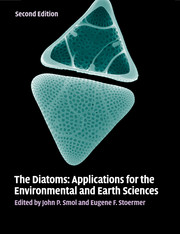Book contents
- Frontmatter
- Contents
- List of contributors
- Preface
- Part I Introduction
- Part II Diatoms as indicators of environmental change in flowing waters and lakes
- Part III Diatoms as indicators in Arctic, Antarctic, and alpine lacustrine environments
- Part IV Diatoms as indicators in marine and estuarine environments
- Part V Other applications
- 24 Diatoms of aerial habitats
- 25 Diatoms as indicators of environmental change in wetlands and peatlands
- 26 Tracking fish, seabirds, and wildlife population dynamics with diatoms and other limnological indicators
- 27 Diatoms and archeology
- 28 Diatoms in oil and gas exploration
- 29 Forensic science and diatoms
- 30 Toxic marine diatoms
- 31 Diatoms as markers of atmospheric transport
- 32 Diatoms as non-native species
- 33 Diatomite
- 34 Stable isotopes from diatom silica
- 35 Diatoms and nanotechnology: early history and imagined future as seen through patents
- Part VI Conclusions
- Glossary, acronyms, and abbreviations
- Index
- References
30 - Toxic marine diatoms
from Part V - Other applications
Published online by Cambridge University Press: 05 June 2012
- Frontmatter
- Contents
- List of contributors
- Preface
- Part I Introduction
- Part II Diatoms as indicators of environmental change in flowing waters and lakes
- Part III Diatoms as indicators in Arctic, Antarctic, and alpine lacustrine environments
- Part IV Diatoms as indicators in marine and estuarine environments
- Part V Other applications
- 24 Diatoms of aerial habitats
- 25 Diatoms as indicators of environmental change in wetlands and peatlands
- 26 Tracking fish, seabirds, and wildlife population dynamics with diatoms and other limnological indicators
- 27 Diatoms and archeology
- 28 Diatoms in oil and gas exploration
- 29 Forensic science and diatoms
- 30 Toxic marine diatoms
- 31 Diatoms as markers of atmospheric transport
- 32 Diatoms as non-native species
- 33 Diatomite
- 34 Stable isotopes from diatom silica
- 35 Diatoms and nanotechnology: early history and imagined future as seen through patents
- Part VI Conclusions
- Glossary, acronyms, and abbreviations
- Index
- References
Summary
Introduction
Diatoms are major contributors to total primary production as well as many important biogeochemical processes in aquatic environments (Falkowski et al., 1998; Smetacek, 1999). Nonetheless, a small number of species (<30) have been recognized as harmful to fisheries, wildlife, or people, through production of either a toxin or various exudates, or via mechanical damage due to cell morphology and/or high biomass accumulation. Fryxell & Villac (1999), and more recently Fryxell & Hasle (2003), have identified several of these harmful taxa and outlined their often devastating impacts on other organisms, ecosystems, and economies. Examples include: oily surface films associated with bird mortalities (Coscinodiscus centralis Ehrenb., Coscinodiscus concinnus W. Smith); surface accumulations on beach surf-zones affecting tourism/recreation (Asterionellopsis glacialis [Castracane] Round, Anaulus australis Drebes & D. Schulz; in Villac & Noronha, 2008); mucilage production causing a condition known as “mare sporco” (or dirty sea) (Ceratoneis closterium Ehrenb., Pseudo-nitzschia pseudodelicatissima [Hasle] Hasle) as well as clogging of bivalve gills (Thalassiosira mala Takano) and fishing nets (Guinardia striata [Stolterfoth] Hasle, Coscinodiscus wailesii Gran & Angst); high biomass accumulations resulting in shading and depletion of oxygen/nutrients (C. wailesii) as well as clogging gills of benthic shellfish and bony fish (Cerataulina pelagica [Cleve] Hendey); and spines/setae inflicting physical damage to fish gills leading to major financial losses for aquaculture operations (Chaetoceros convolutus Castracane and Chaetoceros concavicornis Mangin).
- Type
- Chapter
- Information
- The DiatomsApplications for the Environmental and Earth Sciences, pp. 540 - 551Publisher: Cambridge University PressPrint publication year: 2010
References
- 5
- Cited by



